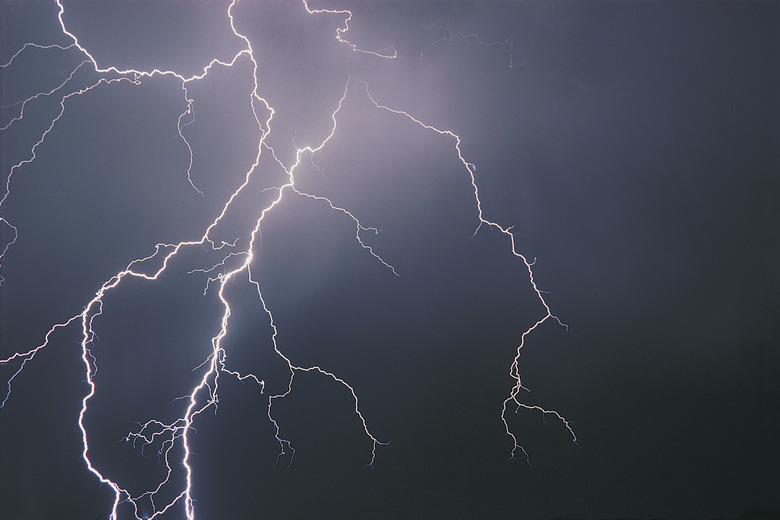Does Lightning Help Grass Grow?
More than a few homeowners know the widespread belief that a thunderstorm results in greener grass. That may or may not be exactly true, but what's undeniable is that such a storm's electrical display does contribute to plant nutrition and thus helps to some degree with the growth of grass. The connection might seem hard to grasp – what does a flash of lightning contribute to the health of turf? – but it's actually fairly straightforward, and an example of one of the planet's fundamental, life-sustaining physical cycles.
Nitrogen Availability
Nitrogen Availability
Nitrogen is an essential nutrient for plants and other organisms, being a fundamental part of nucleic acids, amino acids and proteins, not to mention the photosynthesizing plant pigment called chlorophyll. It's also the single most abundant gas in the Earth's atmosphere, accounting for about 78 percent of its composition. (Oxygen is the second-most abundant atmospheric gas, at about 20 percent.) Despite that abundance, atmospheric nitrogen (N2) isn't readily available to most lifeforms, basically because in this tightly bonded form it isn't very reactive with other molecules. Only a relative few living things – certain kinds of bacteria, including the cyanobacteria loosely referred to as "blue-green algae" – can directly use it as is. Other organisms require nitrogen to be transformed, or "fixed," into more reactive compounds such as nitrates (NO3) or ammonia (NH3) before they can use it for biological growth and processes.
Nitrogen Fixation and the Nitrogen Cycle
Nitrogen Fixation and the Nitrogen Cycle
The process by which nitrogen is converted into a form usable to most organisms is called nitrogen fixation. The most significant pathway of nitrogen fixation is via the bacteria that can change the nitrogen molecule into nitrogen compounds such as ammonia. Some of these nitrogen-fixing microbes have symbiotic relationships with plant roots.
Atmospheric fixation is another way nitrogen gas can be transformed into nitrates and ammonia, and lightning is the means. Humans also artificially accomplish nitrogen fixation in the industrial production of fertilizers.
The conversion of nitrogen into biologically available compounds via fixation as well as other processes such as bacterial nitrification, and the release of nitrogen back into the soil and the atmosphere through organic decay and denitrification, creates the nitrogen cycle, one of the core circuits defining the Earth's biosphere.
Lightning, aka Atmospheric Fixation of Nitrogen
Lightning, aka Atmospheric Fixation of Nitrogen
The tremendous heat released by a bolt of lightning – some 50,000 degrees Fahrenheit, roughly five times the temperature of the sun's surface – can split apart a nitrogen molecule to free up two nitrogen atoms. A liberated nitrogen atom can then bond with oxygen atoms to form nitrogen oxides that, dissolving into raindrops, become nitrates. The lightning-freed nitrogen may also bond with atmospheric hydrogen to form ammonia. These soluble nitrogen compounds then fall to the Earth in rainfall, providing a natural, lightning-produced fertilizer for grass and other plants.
When you consider that some 40 lightning bolts flash over the (mighty stormy) Earth every second, you get a sense for the significance of this atmospheric nitrogen fixation, even if it's overall less important than biological fixation. It's been estimated that lightning produces roughly 13,000 tons of nitrates each day around the globe.
Lightning and Greener Grass?
Lightning and Greener Grass?
There's no question that lightning provides a source of nitrogen useful for growing grass. As to whether grass will actually turn greener directly on the heels of a thunderstorm – well, that's a bit of a murkier connection. Rainfall itself, whether associated with a cumulonimbus cloud or not, can result in a greener lawn given both the moisture it's providing and the nitrates and ammonia ultimately produced by lightning – though not necessarily locally – which will contribute to green-hued chlorophyll production. Heavy downpours from a thunderstorm may also simply wash dust off grass leaves, resulting in a lusher, more vibrant appearance.
References
- North Carolina Department of Agriculture and Consumer Services' Kids World Web Page: Plant Nutrients
- NOVA: Earth From Space – Lightning Produces Nitrates
- University of Wisconsin-Madison: The Weather Guys – Does Lightning Add Nitrogen to the Soil?
- NickelBlock Forecasting: Wx Info – Does Lightning Make My Grass Greener?
Cite This Article
MLA
Shaw, Ethan. "Does Lightning Help Grass Grow?" sciencing.com, https://www.sciencing.com/does-lightning-help-grass-grow-12003078/. 30 September 2021.
APA
Shaw, Ethan. (2021, September 30). Does Lightning Help Grass Grow?. sciencing.com. Retrieved from https://www.sciencing.com/does-lightning-help-grass-grow-12003078/
Chicago
Shaw, Ethan. Does Lightning Help Grass Grow? last modified March 24, 2022. https://www.sciencing.com/does-lightning-help-grass-grow-12003078/
